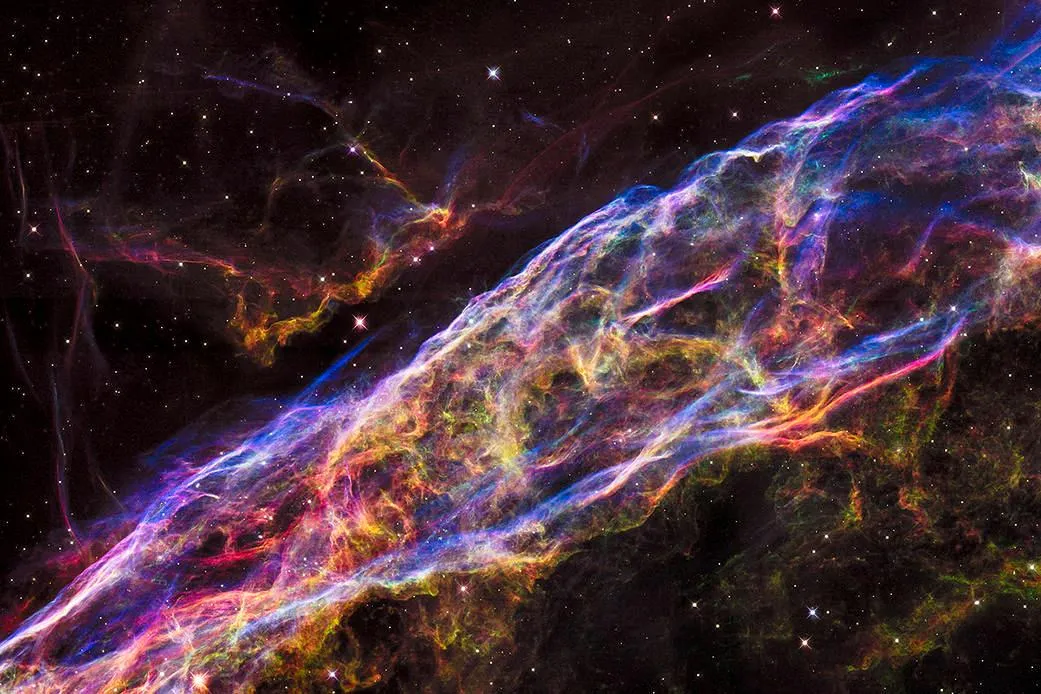NASA Reveals Spectacular New Hubble Telescope Image of the Veil Nebula
Advanced processing techniques brought out finer details of the nebula’s filaments and delicate threads of translucent ionized gas
:focal(342x525:343x526)/https://tf-cmsv2-smithsonianmag-media.s3.amazonaws.com/filer/b8/8d/b88d2904-2b1d-42a1-8c80-84c30ced8625/potw2113a.jpg)
Located 2,100 light-years from Earth in the constellation Cygnus lies a supernova remnant called the Veil Nebula. The nebula is a cloud of ionized gas and dust that formed approximately 10,000 years ago when a star 20 times the size of our sun self-detonated and spewed plasma into the dark sky, reports Michelle Starr for Science Alert.
In 2015, NASA's Hubble Space Telescope snapped a tiny fraction of the Veil Nebula's vast structure. The total of six snapshots pieced together show wisps of glowing filamentary structures in the Veil. On April 2, NASA revealed a reprocessed image of the Veil Nebula from 2015 that further enhanced details of the various hues and threads of ionized gas that make up the hot gas cloud.
The photo from 2015 was taken using the Hubble telescope’s Wide Field Camera 3 along with five different filters, NASA explains in a statement. Using new processing techniques, NASA created a sharper image that brought out various hues of gases and highlighted minor details like the interwoven threads of filaments, reports Kellen Beck for Mashable. In the reprocessed image, ionized oxygen is seen in blue, ionized hydrogen and nitrogen glow red, reports Kasandra Brabaw for Space.com.

When the dying star tranformed into a supernova, the shockwaves and debris from the aftermath carved and weaved the intertwining filaments and the Veil Nebula’s shape. Researchers suspect a mighty wind emitted before the star exploded shaped the Veil's hollow cavities, reports Science Alert. Once the supernova shockwave hit the nebula, it shocked and energized the gases within, creating the various translucent filaments of the Veil.
The Veil Nebula is only one visible part of the entire supernova remnant, the Cygnus Loop. Images that capture nebulas help astronomers understand what happens after stellar explosions and how filaments emit different wavelengths of light and color, Science Alert reports. Photos can also help researchers understand how nebulas expand and change as shockwaves continue to interact with it. Using photos taken by the Hubble telescope in 1997 and comparing them to the image taken in 2015, astronomers calculated the Veil is expanding 1.5 million kilometers per hour, or 932,000 miles per hour.
For those who want to catch a glimpse of the Veil Nebula, no fancy equipment is needed. The Veil can be seen with binoculars when sky conditions are optimal. The Veil was first identified in 1784 by astronomer William Herschel, Mashable reports.
/https://tf-cmsv2-smithsonianmag-media.s3.amazonaws.com/accounts/headshot/gamillo007710829-005_0.png)
/https://tf-cmsv2-smithsonianmag-media.s3.amazonaws.com/accounts/headshot/gamillo007710829-005_0.png)